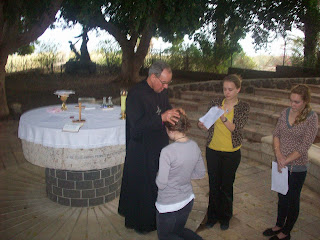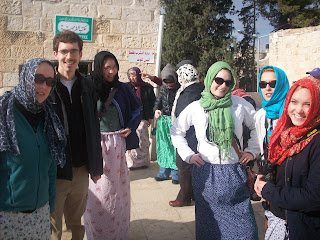Well everyone, we are on our way back. I’m sitting here in Ben Gurion, pecking away at the keyboard of Judith’s undersized laptop. It seems like just yesterday that we passed through this same place, but at the same time so much has happened since then. It has been an incredible week for all of us; I think it’ll take some time to really process what we’ve experienced and discover the full meaning of the world we are leaving behind – but one we will never forget.
Hand it to Bob and Maurine – a day walking around the town that Jesus grew up in was the perfect way to wrap up our week-long pilgrimage to Israel and Palestine. We met our tour guide, Azar, after breakfast and began hiking up the hill to visit Don Bosco, an Arab school.
The Church at Don Bosco
The view was simply incredibly; the entire city of Nazareth was spread out before us, and Mt. Precipice – where Luke says an angry mob once attempted to throw Jesus off a cliff – stood tall in the distance.
We then descended the hill, passing through the busy marketplace to the Basilica of the Annunciation, which stands over the location where Mary was visited by an angel. We followed Azar inside, passing by the ancient Crusader and Byzantine ruins. There’s not much left – only a small grotto – but the altar remains inside. The walls are lined with beautiful mosaics that almost every country in the world has donated to the basilica (to be honest, ours isn’t particularly stunning). The upper level is entirely dedicated to Mary.
Basilica of the Annunciation
We stopped by St. Joseph’s and the Greek Orthodox Church before heading to the Sisters of Nazareth Convent. Our first order of business there was to explore the underground ruins beneath the convent, which were discovered in the waning years of the 19th. century. There are some pretty impressive archeological designs: 1st century tombs (which had housed the skeleton of what excavators believed to be a bishop), and structures build by both the Crusaders and the Byzantines. One of the tombs in particular garnered our interest – one which shared the same model of the tomb that Jesus was resurrected in.
After a while poking around the musty (but still fascinating) ruins, we returned outside. Bob handed us each some shekels, and set us loose upon the Nazareth marketplace to find our own lunches and peruse the shops and sights.
The Nazareth Marketplace
There were a few pretty good finds, including a sweet shop with everything from Turkish Delight to honey balls (amazing!), and an Arabic pizza parlor that served pizza on pita bread. Once we were all shekel-ed out, we returned to the convent.
We were all looking forward to the last event on the program: a visit from Knesset member Haneen Zoabi, one of only 11 Palestinians to represent the 1.2 million that live within the country. She spoke passionately to us about the political aspect of Palestinian self-identity. While Palestinians with Israeli citizenship are commonly referred to as Arab Israelis, Zoabi rejects that term as a denial of her own historic and cultural identity as a Palestinian.
Haneen Zoabi (far left)
To be an Israeli citizen, she told us, the country demands that they deny their own Palestinian identity. To call herself Palestinian is to be “disloyal” to the state. Much of her work is to reverse that notion, and to make a Palestinian heritage a thing of pride and not of disloyalty. We hope and pray that she will help lead the way to political and social equality for all Palestinians.
And with that, our pilgrimage came to a conclusion. We returned to St. Margaret’s for a final debrief and dinner. As we were to leave Nazareth at 3am, some chose an early bedtime, while a few bolder ones (those crazy kids) elected to stay up all night.
And so we return to the States. Barely a week has passed, but so much has changed. We return with an awareness of a beautiful and holy land halfway across the globe. The land where our Lord lived, ministered, and died for us. We have followed in His footsteps to continue that never-ending quest to be close to Him. We have prayed, and we have felt His presence.
But we also return with an awareness of a terrible and cruel land. We have witnessed the occupation and oppression of the Palestinian people, on the same earth that Jesus called us to show love, kindness, and mercy to all. And so we are called to do what we can. Jesus tells us that helping the least of His brothers is to do His work, and so that is our mission.
Just to conclude, I’d like to thank some who helped to make this wonderful pilgrimage possible. Thanks to all of you, for your constant support over the past few months; thanks to Bob and Maurine Tobin, who planned and led the trip and provided a wealth of knowledge and understanding to us; Judith, who helped organize and lead the trip, and was also a wonderful resource to all of us who needed anything; Brandy, who managed our finances; Trish, who helped chaperone; Shan, who created and maintained this blog; Bishop Tom Shaw, who was an incredible spiritual resource the days that he was with us; and Mohammed, our driver who not only can maneuver a gigantic tour bus with the precision of a brain surgeon, but was an amazing friend to us (he even got us snacks when he was waiting for us to return!). You have created an experience that none of us will forget.
And we’ll be seeing you all, our families and friends, very soon. Thanks for taking the time to read and follow us on our journey. We look forward to returning home, but we will never forget what we have experienced and learned here.
God bless,
MacLean Cadman
Communication, 2012
Boston College



















































